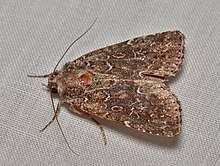Condica capensis
Condica capensis is a moth of the family Noctuidae. It is found across Africa, the Indian sub-continent and South-East Asia. In Europe, it is only common in southern Spain, but can be found further north.
| Condica capensis | |
|---|---|
 | |
| Scientific classification | |
| Kingdom: | Animalia |
| Phylum: | Arthropoda |
| Class: | Insecta |
| Order: | Lepidoptera |
| Superfamily: | Noctuoidea |
| Family: | Noctuidae |
| Genus: | Condica |
| Species: | C. capensis |
| Binomial name | |
| Condica capensis (Guenée, 1852) | |
| Synonyms | |
| |
Technical description and variation
Forewing fuscous on a rufous ground, dusted with grey along costa, below and beyond lower angle of cell, and along termen; the veins dark; inner and outer lines conversely lunulate-dentate, the teeth marked by black and white points, the lunules yellow; subterminal line whitish, dentate, preceded by small tooth shaped black spots; claviform stigma small, outlined in black; orbicular small, constricted in middle, the centre brown and ring pale; reniform with centre yellowish in upper half, white in lower, this lower lobe surrounded with small white dots outlined in black; hindwing dull white, the veins and termen suffused with brown, or wholly brown in female. Larva smooth, pale green, the anal segment humped; a series of purplish brown dorsal and lateral blotches dappled with white; a sublateral series of white dots; pupa greenish, with the segmental incisions reddish. [1] The wingspan is 28–36 mm.
Biology
The larvae feed on various herbaceous plants, including Carthamus tinctorius.
References
- Warren. W. in Seitz, A. Ed., 1914 Die Großschmetterlinge der Erde, Verlag Alfred Kernen, Stuttgart Band 3: Abt. 1, Die Großschmetterlinge des palaearktischen Faunengebietes, Die palaearktischen eulenartigen Nachtfalter, 1914
